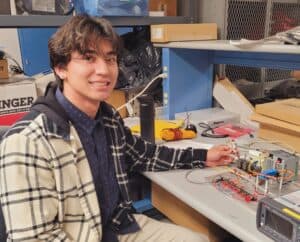
Logan Waltjen was born and raised on the Big Island of Hawai‘i. He graduated high school from Kamehameha Schools Hawai‘i, and now attends Grand Canyon University in Arizona. He is pursuing a major in Electrical Engineering and plans to contribute to his community by using the knowledge he has learned in school and the workforce. In his spare time, Logan enjoys hanging with friends and exercising.
Home Island: Big Island of Hawaii
High School: Kamehameha Schools Hawai‘i
Institution when accepted: Grand Canyon University
Improving the Cooling Switch System for the Prime Focus Spectrograph
Project Site: Subaru Telescope, Hilo, HI
Mentor: Lucio Ramos
Project Abstract:
The Subaru Telescope, located on the summit of Maunakea, currently uses an instrument called the Prime Focus Spectrograph (PFS). There are two PFS modules installed, with plans of installing two more in the near future. These modules are situated in the Spectrograph Clean Room located on the fourth floor of Subaru Telescope’s corotating enclosure. The primary cooling system for the spectrograph modules consists of a recirculating thermo-chiller, SMC, and a liquid-to-liquid heat exchanger, Lytron LCS20. If the primary cooling system fails, the backup liquid-to-air heat exchanger, Lytron 6340, will be used and continue to cool the spectrograph cryocoolers by exhausting resulting heat directly inside the telescope enclosure. Currently, switching from primary to backup cooling must be done manually. To reduce downtime and potential damage to the spectrograph modules, we are developing and testing an automated switch system in the lab. The automated switch system relies on analog signals, and uses a time-delay relay that is activated upon an alarm output to give enough time for scientists to ensure that the back-up system is precooled and can supply the modules with the temperature that is needed. Analysis of the cooling system shows that the primary route of the coolant can be switched to the back-up route through two electric 3-way valves. Designating a threshold for certain flow and temperature monitors in the system allows for alarms to be outputted from data acquisition devices, which will then autonomously trigger the electric 3-way valves to switch to the backup route. Design and testing of a switch system using relays, proprietary software, and data acquisition systems was performed to test the feasibility of switching from facility to backup cooling autonomously.